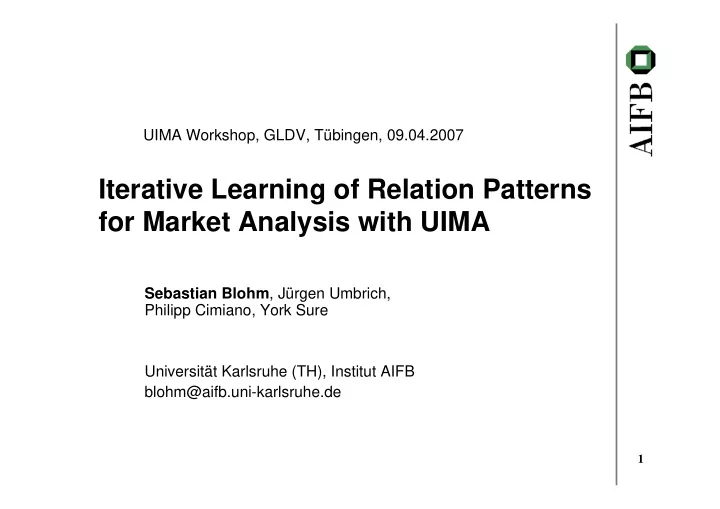

UIMA Workshop, GLDV, Tübingen, 09.04.2007 Iterative Learning of Relation Patterns for Market Analysis with UIMA Sebastian Blohm , Jürgen Umbrich, Philipp Cimiano, York Sure Universität Karlsruhe (TH), Institut AIFB blohm@aifb.uni-karlsruhe.de 1
Motivation - A lot of facts on the Web are not available in structured form. But we would like to have them structured. - The Web is big . For an individual user task, linear-time processing is prohibitive. - We need to be able to derive information on demand and thereby take advantage of previous annotations . - Classical Web search indices allow fast access, but only for pure text . - Structural queries also allow this but require knowledge on the structure of the content . - We therefore want to learn structured queries that combine classical and semantic indices. 2
3 Project context of this work
Outline - Iterative Induction of Patterns - Going for structured queries - How to make structure learnable - Status of work 4
Iterative Pattern Induction - Early text mining information extractors heavily relied on manually defined extraction patterns [Hearst92]. Automatic generation of patterns: - Reduces work - Increases flexibility - Allows population of ontologies with many different relations. - Our approach: - Input: Few instances of a relation - Process: Use Web search to identify how relation instances are typically mentioned. - Output: Patterns that allow extracting many instances through web search. 5
Learning Patterns from Occurrences All possible merges of patterns are considered. Example merge: The happiest people in Germany live in Osnabrück . The richest people in America live in Hollywood. The * people in * live in * . Related Work • Static Patterns [Hearst 1992] • Bootstrapped Learning on search index [Brin 1998] • Wrapper Induction [Kushmerick 2000] • Large Scale Systems [Etzioni et al., 2005] 6
The PRONTO system Match Tuples Filter Tuples Learn Patterns Extract Tuples Filter Patterns Match Patterns 7
Design Choices Structure of Patterns - Lists of words (cleaned) - Only occurrences with a max argument distance of 4 are considered. - Window of processing: 2 words before the first and after the last argument. - Punctuation is kept (punctuation chars are distinct words) - Capitalization is checked for. Nature of queries Tuples: just full text of the arguments Patterns: quote, use * wildcard, remove surrounding wildcards "flights to * , * from northeast“ 8
Going for more complex patterns Clearly, processing would benefit from - Gazetteers - Shallow linguistic processing - Other UIMA annotators This leads to : - better extraction performance - general patterns that can be used for large scale annotation (sub- linear performance) ... but it would need to learn, how to employ the annotations . This means, we need to formalize text and annotations in a way that allows: - Structural querying - Abstraction for learning 9
10 Where UIMA comes into play
Representing Annotations in Patterns (sub- optimal) NP PP V PP NP VP The * people in * live in * . POS=... POS=NN POS= ADJ POS=NN ... POS=.. ... POS=NN . ... Surface=* Surface=* Surface=peo.. Surface=* Cap=* Cap=* Cap=* Cap=small NP1=1 NP1=1 NP1=1 NP start =1 NP start =0 NP start =0 NP end =0 NP end = NP end =1 • For the learning phase, patterns are represented as feature vectors for each token. • UIMA Annotations indicate spans of text. • Translation: Represent beginning, end and arbitrary position 11 • Learning consists of eliminating too specific features
Querying for complex patterns Key points: • Combine textual matches with structual matches • Enforce order but not everywhere • Make annotations as " atomic “ as possible to allow abstraction along many dimensions. • Is annotation overload an issue? The * people in * live in * . POS=... POS=NN POS= ADJ POS=NN ... POS=.. ... POS=NN . ... Surface=* Surface=* Surface=peo.. Surface=* Cap=* Cap=* Cap=* Cap=small NP1=1 NP1=1 NP1=1 NP start =1 NP start =0 NP start =0 NP end =0 NP end = NP end =1 <S> <NP>“The“<token POS="ADJ“/>“people in“</NP> <#token POS="NN"/>“live in“<#token POS="NN"/> 12 </S>
Status of Work PRONTO System • Ready for Web extraction with pure text patterns [AAAI 07] • Exposed Plug-In API: almost there UIMA Integration • Annotators to identify objects of various classes: done • Integration with OmniFind: 80% done • Matching procedures: ongoing Future Plans • Visualization for market analysis • Smarter pattern learning • Any ideas? 13
Thank you for your attention Sebastian Blohm , Jürgen Umbrich, Philipp Cimiano, York Sure Universität Karlsruhe (TH), Institut AIFB blohm@aifb.uni-karlsruhe.de 14
References [Hearst92] M. A. Hearst, \Automatic acquisition of hyponyms from large text corpora," in Proceedings of the 14th conference on Computational linguistics. Morristown, NJ,USA: Association for Computational Linguistics, 1992, pp. 539-545. [DIPRE98] S. Brin, \Extracting patterns and relations from the world wide web," in WebDB Workshop at 6th International Conference on Extending Database Technology,EDBT'98 , 1998. [KnowItAll05] O. Etzioni, M. Cafarella, D. Downey, A.-M. Popescu, T. Shaked, S. Soderland,D. S. Weld, and A. Yates, \Unsupervised named-entity extraction from the web: an experimental study," Artif. Intell., vol. 165, no. 1, [Snowball00] E. Agichtein and L. Gravano, \Snowball: extracting relations from large plain-text collections," in DL '00: Proceedings of the ¯ fth ACM conference on Digital libraries . New York, NY, USA: ACM Press, 2000 [Espresso06] M. Pennacchiotti and P. Pantel, \A bootstrapping algorithm for automatically harvesting semantic relations," in Proceedings of Inference in Computational Semantics (ICoS-06), Buxton, England. [CIA01] http://www.daml.org/2001/12/factbook/ [AAAI07] S. Blohm, P. Cimiano and Egon Stemle: "Harvesting Relations from the Web – Quantifying the Impact of Filtering Functions“. In Proceedings of the AAAI 2007. Vancouver, Canada. (to appear) [Etzioni et al., 2005] Oren Etzioni, Michael J. Cafarella, Doug Downey, Ana-Maria Popescu, Tal Shaked, Stephen Soderland, Daniel S. Weld, Alexander Yates: Unsupervised named-entity extraction from the Web: An experimental study. Artificial Intelligence 165(1): 91-134 (2005) 15
Recommend
More recommend